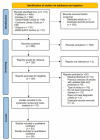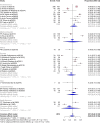Risk factors for recurrences and visual impairment in patients with ocular toxoplasmosis: A systematic review and meta-analysis
- PMID: 37011101
- PMCID: PMC10069780
- DOI: 10.1371/journal.pone.0283845
Risk factors for recurrences and visual impairment in patients with ocular toxoplasmosis: A systematic review and meta-analysis
Abstract
Background: Ocular toxoplasmosis (OT) is caused by the parasite Toxoplasma gondii. OT is the leading cause of posterior uveitis globally; it is a recurrent disease that may result in visual impairment and blindness. This systematic review and meta-analysis aim to summarize and evaluate the risk factors for recurrences, visual impairment, and blindness described in the literature worldwide.
Methods and findings: We performed a systematic literature search in PubMed, Embase, VHL, Cochrane Library, Scopus, and DANS EASY Archive. All studies reporting patients with clinically and serologically confirmed OT presenting any clinical or paraclinical factor influencing recurrences, visual impairment, and blindness were included. Studies presenting secondary data, case reports, and case series were excluded. An initial selection was made by title and abstract, and then the studies were reviewed by full text where the eligible studies were selected. Then, the risk of bias was assessed through validated tools. Data were extracted using a validated extraction format. Qualitative synthesis and quantitative analysis were done. This study was registered on PROSPERO (CRD42022327836).
Results: Seventy two studies met the inclusion criteria. Fifty-three were summarized in the qualitative synthesis in three sections: clinical and environmental factors, parasite and host factors, and treatment-related factors. Of the 72 articles, 39 were included in the meta-analysis, of which 14 were conducted in South America, 13 in Europe, four in Asia, three multinational, two in North America and Central America, respectively, and only one in Africa. A total of 4,200 patients with OT were analyzed, mean age ranged from 7.3 to 65.1 year of age, with similar distribution by sex. The frequency of recurrences in patients with OT was 49% (95% CI 40%-58%), being more frequent in the South American population than in Europeans. Additionally, visual impairment was presented in 35% (95% CI 25%-48%) and blindness in 20% (95% CI 13%-30%) of eyes, with a similar predominance in South Americans than in Europeans. On the other hand, having lesions near the macula or adjacent to the optic nerve had an OR of 4.83 (95% CI; 2.72-8.59) for blindness, similar to having more than one recurrence that had an OR of 3.18 (95% CI; 1.59-6.38). Finally, the prophylactic therapy with Trimethoprim/Sulfamethoxazole versus the placebo showed a protective factor of 83% during the first year and 87% in the second year after treatment.
Conclusion: Our Systematic Review showed that clinical factors such as being older than 40 years, patients with de novo OT lesions or with less than one year after the first episode, macular area involvement, lesions greater than 1 disc diameter, congenital toxoplasmosis, and bilateral compromise had more risk of recurrences. Also, environmental and parasite factors such as precipitations, geographical region where the infection is acquired, and more virulent strains confer greater risk of recurrences. Therefore, patients with the above mentioned clinical, environmental, and parasite factors could benefit from using prophylactic therapy.
Copyright: © 2023 Cifuentes-González et al. This is an open access article distributed under the terms of the Creative Commons Attribution License, which permits unrestricted use, distribution, and reproduction in any medium, provided the original author and source are credited.
Conflict of interest statement
The authors have declared that no competing interests exist.
Figures









References
-
- Weiss L, editor. Toxoplasma gondii. Waltham: Elsevier; 2020.
-
- Peyron F, Lobry JR, Musset K, Ferrandiz J, Gomez-Marin JE, Petersen E, et al.. Serotyping of Toxoplasma gondii in chronically infected pregnant women: predominance of type II in Europe and types I and III in Colombia (South America). Microbes Infect. 2006;8: 2333–2340. doi: 10.1016/j.micinf.2006.03.023 - DOI - PubMed
-
- Timsit JC, Bloch-Michel E. [Efficacy of specific chemotherapy in the prevention of recurrences of toxoplasmic chorioretinitis during the 4 years following the treatment]. J Fr Ophtalmol. 1987;10: 15–23. - PubMed
Publication types
MeSH terms
LinkOut - more resources
Full Text Sources
Miscellaneous

